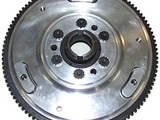Great leaps forward in technology since the Mini’s inception have been constantly applied to all forms of automotive applications. The Mini flywheel and pressure plate are no exceptions. If for no other reason than weight reduction - an admirable one considering the effects it can have (see 'Flywheel & Pressure Plate - Effects of lightening' for benefits of lightening).
Two companies have seen fit to apply this knowledge - KAD in Kent, and Manx Racing in Wiltshire. KAD have produced their aluminium-alloy flywheel and pressure plate using a special plasma-sprayed metal friction surface - originally developed by the MOD apparently!! Manx’s versions have a special steel insert screwed to the respective pieces to provide the friction area. In fact Manx do two versions - the ‘across the counter’ type and the ‘works fitted’ type. The works type is super light but needs constant appraisal to avoid catastrophes. The Manx way allows replacement friction surfaces without having to renew the main body of each piece, thus keeping long-term costs down. The KAD style does not facilitate this, but I understand that wear is not a problem - unless something unforeseen happens that is. Here’s how they compare in the ‘weight’ league;
| LB | KG | |
| Steel Flywheel - U/light | 8.38 | 3.80* |
| KAD Flywheel | 7.92 | 3.60 |
| Manx Flywheel | 6.75 | 3.07 |
| Manx Flywheel - U/light | 4.50 | 2.05 |
| MSC SG iron P/plate | 3.56 | 1.62 |
| KAD Pressure plate | 2.51 | 1.14 |
| Manx Pressure plate | 2.75 | 1.25 |
| Manx P/plate - U/light | 2.13 | 0.97 |
*For comparison purposes - Mad, eh?
Technology has also seen some improvements, although more reliability orientated, to the age-old steel flywheels. For years there was more or less only one ultra-light version available. During development of harmonic dampers, Mini Spares came across some odd harmonics on the engine they were using as a test bed. It was causing inconsistent harmonics up and down the rev-range that were potentially failure-inducing of the whole crank assembly. And something that a harmonic damper would not necessarily totally arrest. Investigation with a strobe highlighted the outer section of the flywheel flexing, caused by the extended thin section of the outer edge/ring gear. So they made their own, splitting the original three long slots and three round holes into six even slots. Problem solved!! And allowed them to address/correct consistency problems from the then lone supplier of the crank taper and clutch face angles/finish.








